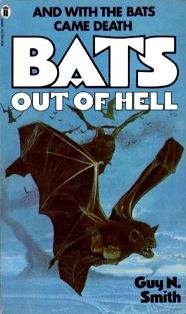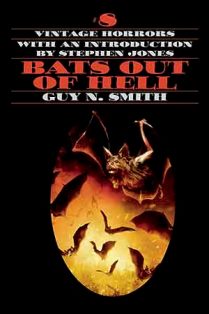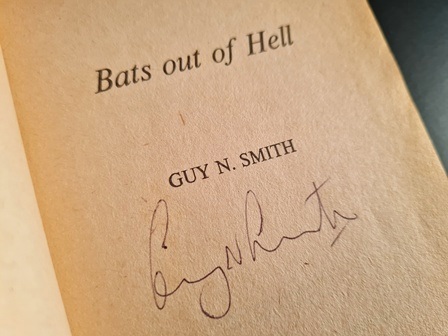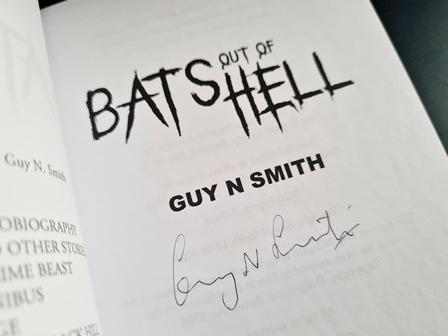
First Edition

Centipede Press Hardback
First published back in July of 1978, Guy N Smith’s pulp horror classic ‘Bats Out Of Hell’ is one of the British author’s early horror novels that eventually paved the way for an incredibly prolific career in horror writing.
Over the following years ‘Bats Out Of Hell’ would see a number of reprints, as well as being included within the ‘A Bargain Bumper Treble’ (1978) omnibus.
In October of 2022, the novel was re-released by Centipede Press as Book #8 of their ‘Vintage Horrors’ series. This limited edition hardback was limited to just 400 numbered editions. The hardback book included a new 10-page introduction by horror editor Stephen Jones as well as new artwork by Ben Baldwin. Each book was signed by both Jones and Baldwin, as well as including a facsimile of Guy N Smith’s signature (as this was a posthumous release).
DLS Synopsis:
In the Midlands Biological Research Centre, Professor Brian Newman has accidently created a new and deadly virus on a number of his experimental bats. The virus seems similar to that of meningitis in many ways. However, the infected bat later develops what appears to be a state of abnormal madness, with its natural radar sense left completely useless. The highly infectious virus then leaves the carrier in a paralysed state of rigor mortis until death finally takes hold of the poor victim. Later on that night, Newman’s laboratory helper and lover Susan Wylie catches Newman at a local bar with another young female. It appears that Newman is surprisingly a bit of a ladies man!
The following morning an argument breaks out between the two scientists, escalating until the glass cage that holds Newman’s test bats is broken, and the infected creatures escape from their prison into the wide open world.
Newman attempts to convince his superiors, Professor Haynes and Professor Rickers, that these escaped bats could mean an outbreak of a new deadly virus that could build into an epidemic of catastrophic proportions. Alas, after a number of tests are performed, the two Professors come to the mistaken conclusion that the deadly virus never really existed.
However soon enough, a local family are infected with the deadly virus when they encounter the bats sheltering in their horse’s stables. Next to fall victim to the erratic and lethal bats are the pupils of St Chad’s Cathedral School during a service held by their headmaster. Mayhem ensues, with the highly contagious bats infecting a large number of the boys.
By now the press has got hold of the story and a nationwide panic is underway. When a bat gets into the highly secure confines of the Bank’s Treasury, located in the heart of Birmingham city, the government moves in and declares Birmingham and its suburbs to be a quarantined area. No one is to enter or leave the city. The government enlists the help of the armed forces, the police forces along with employing a volunteer service named the BVF, to maintain this authority.
Before long riots are breaking out in the streets of Birmingham, with vigilante groups targeting those seen to be in authority. A number of thugs attempt to take their revenge on Newman, when word gets out that it was him and him alone who is responsible for this deadly outbreak.
With pandemonium everywhere, Newman has his work cut out for him if he is to either find a cure for the virus or find a way to kill off all of the infected bats. When mice and rats show signs of carrying the disease, drastic measures are needed to save the population of the UK...
DLS Review:
The novel is relatively slow to start off with, as Smith lays down the groundwork for the dramatic premise that gradually escalates into gigantic proportions. Indeed, once the bats are finally loose and infecting those who come into contact with them, the novel takes up a stampeding fast pace, with one wildly dramatic event preceding another until the final curtain is pulled.
Each sighting of the infected bats that takes place escalates the amount of victims involved, until the moment when the entire city of Birmingham is secured by the government. At this point the novel takes on a whole new angle, with an almost post-apocalyptic situation of urban rioting and warfare taking dominance over the storyline. Smith delivers page after page of bloodthirsty violence and mob-rule madness that just pumps out adrenaline and edge-of-the-seat action.
With sheer chaos around every corner, this erupting mayhem adds further weight to the utter desperation of Newman’s endeavours. At the same time, a number of carefully intertwined sub-stories bring a purposeful insight into these brutal scenes across the streets of Birmingham. The result is an impactful and engaging vision of chaos that quickly stamps its mark on the progress of the plot.
Like with the finale of Smith's classic novel ‘Night Of The Crabs’ (1976), Smith almost back-headedly inserts a very helpful answer to the deadly virus that quite clearly should have been incorporated at an earlier stage within the storyline. Still, this somewhat weak escape does not really detract from an otherwise well delivered ending.
The characters throughout the novel are almost unanimously clichéd, apart from Newman who is a peculiar mix of many conflicting character traits. However, Smith purposefully focuses more on the action packed sightings of the bats and the ensuing panic around them, than dwelling on the intricacies of the characters involved. This is very much the correct route to take with such an action packed and unashamedly over-the-top tale.
From the moment of the first ‘bat attack’ Smith has delivered a truly incredible piece of pulp horror literature. The novel barely ever lets up from the fast-paced action, mounting to the crescendo of pandemonium within the streets of Birmingham. This novel really is an absolute must for all fans of 70's pulp horror.
The novel runs for a total of 157 pages.

Over the following years ‘Bats Out Of Hell’ would see a number of reprints, as well as being included within the ‘A Bargain Bumper Treble’ (1978) omnibus.
In October of 2022, the novel was re-released by Centipede Press as Book #8 of their ‘Vintage Horrors’ series. This limited edition hardback was limited to just 400 numbered editions. The hardback book included a new 10-page introduction by horror editor Stephen Jones as well as new artwork by Ben Baldwin. Each book was signed by both Jones and Baldwin, as well as including a facsimile of Guy N Smith’s signature (as this was a posthumous release).
DLS Synopsis:
In the Midlands Biological Research Centre, Professor Brian Newman has accidently created a new and deadly virus on a number of his experimental bats. The virus seems similar to that of meningitis in many ways. However, the infected bat later develops what appears to be a state of abnormal madness, with its natural radar sense left completely useless. The highly infectious virus then leaves the carrier in a paralysed state of rigor mortis until death finally takes hold of the poor victim. Later on that night, Newman’s laboratory helper and lover Susan Wylie catches Newman at a local bar with another young female. It appears that Newman is surprisingly a bit of a ladies man!
The following morning an argument breaks out between the two scientists, escalating until the glass cage that holds Newman’s test bats is broken, and the infected creatures escape from their prison into the wide open world.
Newman attempts to convince his superiors, Professor Haynes and Professor Rickers, that these escaped bats could mean an outbreak of a new deadly virus that could build into an epidemic of catastrophic proportions. Alas, after a number of tests are performed, the two Professors come to the mistaken conclusion that the deadly virus never really existed.
However soon enough, a local family are infected with the deadly virus when they encounter the bats sheltering in their horse’s stables. Next to fall victim to the erratic and lethal bats are the pupils of St Chad’s Cathedral School during a service held by their headmaster. Mayhem ensues, with the highly contagious bats infecting a large number of the boys.
By now the press has got hold of the story and a nationwide panic is underway. When a bat gets into the highly secure confines of the Bank’s Treasury, located in the heart of Birmingham city, the government moves in and declares Birmingham and its suburbs to be a quarantined area. No one is to enter or leave the city. The government enlists the help of the armed forces, the police forces along with employing a volunteer service named the BVF, to maintain this authority.
Before long riots are breaking out in the streets of Birmingham, with vigilante groups targeting those seen to be in authority. A number of thugs attempt to take their revenge on Newman, when word gets out that it was him and him alone who is responsible for this deadly outbreak.
With pandemonium everywhere, Newman has his work cut out for him if he is to either find a cure for the virus or find a way to kill off all of the infected bats. When mice and rats show signs of carrying the disease, drastic measures are needed to save the population of the UK...
DLS Review:
The novel is relatively slow to start off with, as Smith lays down the groundwork for the dramatic premise that gradually escalates into gigantic proportions. Indeed, once the bats are finally loose and infecting those who come into contact with them, the novel takes up a stampeding fast pace, with one wildly dramatic event preceding another until the final curtain is pulled.
Each sighting of the infected bats that takes place escalates the amount of victims involved, until the moment when the entire city of Birmingham is secured by the government. At this point the novel takes on a whole new angle, with an almost post-apocalyptic situation of urban rioting and warfare taking dominance over the storyline. Smith delivers page after page of bloodthirsty violence and mob-rule madness that just pumps out adrenaline and edge-of-the-seat action.
With sheer chaos around every corner, this erupting mayhem adds further weight to the utter desperation of Newman’s endeavours. At the same time, a number of carefully intertwined sub-stories bring a purposeful insight into these brutal scenes across the streets of Birmingham. The result is an impactful and engaging vision of chaos that quickly stamps its mark on the progress of the plot.
Like with the finale of Smith's classic novel ‘Night Of The Crabs’ (1976), Smith almost back-headedly inserts a very helpful answer to the deadly virus that quite clearly should have been incorporated at an earlier stage within the storyline. Still, this somewhat weak escape does not really detract from an otherwise well delivered ending.
The characters throughout the novel are almost unanimously clichéd, apart from Newman who is a peculiar mix of many conflicting character traits. However, Smith purposefully focuses more on the action packed sightings of the bats and the ensuing panic around them, than dwelling on the intricacies of the characters involved. This is very much the correct route to take with such an action packed and unashamedly over-the-top tale.
From the moment of the first ‘bat attack’ Smith has delivered a truly incredible piece of pulp horror literature. The novel barely ever lets up from the fast-paced action, mounting to the crescendo of pandemonium within the streets of Birmingham. This novel really is an absolute must for all fans of 70's pulp horror.
The novel runs for a total of 157 pages.

© DLS Reviews
















